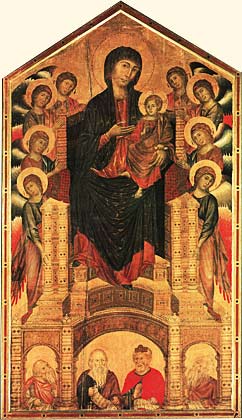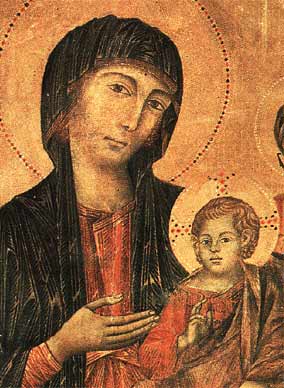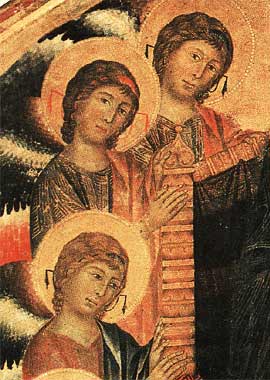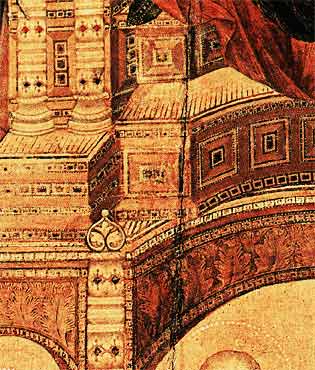
Cimabue (b. Cenni di pepo)
The Santa Trinita Madonna

"...in 1240, Cimabue was born in the city of Florence... to illumine, as it were, the way towards the art of painting."
≈ Giorgio Vasari
Cenni di pepo (ca.1240 - ca.1302), among the most highly regarded artists of his time, is sometimes called the last of the great Byzantine painters. Yet he was also among the first to break with the formalism of Byzantine art, introducing a more lifelike treatment to the traditional subjects.
As a boy in Florence, rather than study his letters, Cenni spent the day drawing in his books a variety of scenes from his imagination. It was probably then that the reputedly arrogant and disdainful young man received his nickname, Cimabue, which roughly translates as "bullheaded." (It was later said he would rather destroy one of his pictures than hear criticism of it.) He apprenticed with a Grecian master, but soon developed his own, less formalized style.
The Santa Trinita Madonna, begun in 1290, originally stood on the high altar of Santa Trinita Chruch in Florence. It was enriched with great expanses of gold leaf and portrayed iconography typical of Medieval painting.
detail 3: the Madonna, slightly smiling,
presents her Child In the center, a solemn and imposing throne, overflowing with almost obsessive designs and patterns, becomes an architectural structure which creates a three-dimensional perspective effect that blends all figures of the composition into a cohesive space.
The gestures, as well as the clothing, conform to Byzantine style, though Cimabue adds details in what seems an attempt to make an emotional connection with the viewer. The Virgin's face has almost the beginning of a smile as she looks out, meeting our eyes and inviting us into a more personal relationship as we worship. Also, the Child's naked feet, projected into the foreground, show the artist was interested in a more intimate portrayal of this iconic scene.

detail 2: arrangement and
spacial perspective of angels
Christ, in a Roman tunic and cloak on his mother's knee, is being presented by the Virgin's gesture to the faithful as He also looks out, fingers raised in priestly blessing. Following Byzantine tradition, the expansive background of gold leaf represents the otherworldly realm against which the heavenly figures stand out.
Artistic advances by Cimabue are evident in the arrangement of angels, all blended into a single scenic space together with the Madonna, and clothed in finely decorated tunics under flowing pink robes. Their tight arrangement both in front of and behind the throne, in mirror image on each side, gives a sense of perspective to the painting as they 'present' the Madonna to the worshipper. The suggestion of receding steps below the Virgin's feet also suggest depth, but still, as in Byzantine icons, the throne lacks a convergence point to give it true perspective.
Yet further suggestion of Cimabue's developing
detail 1: architecture and decoration
of the throne sense of perspective can be seen in the three arches at the throne's base that contain figures of the Prophets Jeremiah, Abraham, King David and Isaiah, sybolizing the foundations of Chrtist's kingdom. The two middle prophets appear to be in a discussion while the outer two are leaning slightly forward and out of the arches as they look up at the Virgin and Child.
By depicting the Prophets leaning outward, as well as by the superimposed angels and concave structure at the base of the throne, Cimabue works to create a more realistic spacial depth in this painting.
Unlike groundbreaking artists to follow (of which two, Giotto and Duccio, were his apprentices), Cimabue's figures do not look at each other or interact. This imparts more of an otherworldy sense to this composition, stressing the holiness of the symbolic image rather than the narrative. Yet Cimabue helped bring art out of the flat Byzantine era and showed the way toward perspective, realism and emotion in painting — a movement which culminated in the Renaissance.
